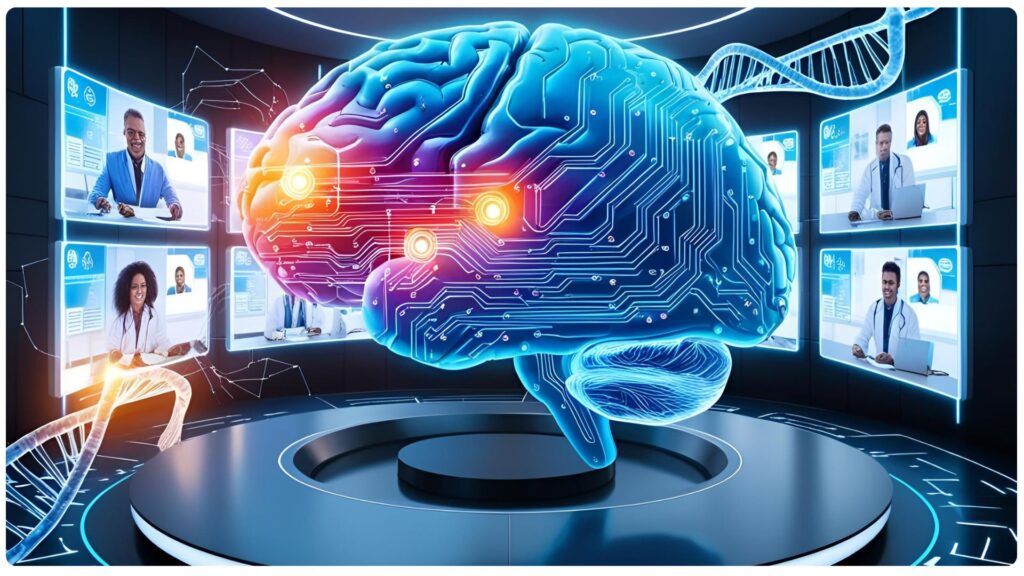Introduction
The healthcare industry is undergoing a monumental transformation driven by digital innovation. Artificial Intelligence (AI), telemedicine, and personalized treatments are reshaping how healthcare is delivered, accessed, and experienced globally. These cutting-edge technologies are not just enhancing medical care but are also revolutionizing preventive health, diagnostics, and patient outcomes. As we move into a more connected and data-driven era, understanding these trends is essential for patients, professionals, and policymakers alike.
The Role of Artificial Intelligence in Modern Healthcare
Enhanced Diagnostics and Decision-Making
Artificial Intelligence in healthcare has significantly improved the speed and accuracy of medical diagnoses. By analyzing vast amounts of medical data, including imaging, lab results, and patient history, AI systems can identify patterns that may be missed by the human eye. Machine learning models have shown impressive results in detecting diseases such as cancer, heart conditions, and neurological disorders.

AI-Powered Administrative Efficiency
Beyond diagnostics, AI is also streamlining administrative workflows in hospitals and clinics. Chatbots, robotic process automation (RPA), and natural language processing (NLP) help reduce paperwork, schedule appointments, and manage billing, allowing healthcare professionals to focus more on patient care.
Ethical Considerations and Bias
Despite its benefits, AI in healthcare raises concerns about data privacy, algorithmic bias, and transparency. It is crucial to ensure that AI systems are trained on diverse datasets to avoid inequalities in healthcare delivery. As Plato once said, “Good people do not need laws to tell them to act responsibly,” reminding us that technological power must be guided by ethical responsibility.
Telemedicine: Bridging the Gap Between Distance and Access
Growth of Remote Consultations
Telemedicine has emerged as a vital component of modern healthcare, especially accelerated by the COVID-19 pandemic. Through video consultations and remote monitoring, patients can access medical expertise from the comfort of their homes. This is particularly valuable in rural and underserved areas where access to specialists is limited.
Benefits for Patients and Providers
Telemedicine offers numerous advantages, including reduced travel time, lower healthcare costs, and improved appointment adherence. For healthcare providers, it enables more flexible schedules and reduced no-show rates. Moreover, remote care minimizes the risk of infections in clinical environments.
Regulatory and Technological Challenges
Despite its rapid adoption, telemedicine faces challenges related to licensing, reimbursement, and technology infrastructure. Governments and health organizations are working to standardize regulations and improve digital literacy to ensure equitable access.
Personalized Medicine: The Era of Tailored Treatments
Understanding Genomic Medicine
Personalized medicine, also known as precision medicine, uses genetic, environmental, and lifestyle data to customize treatments for individual patients. This approach is especially effective in oncology, where targeted therapies based on a patient’s genetic profile are improving survival rates.
Data-Driven Health Insights
With the help of big data analytics, wearable technology, and mobile health apps, personalized medicine empowers patients to take proactive control of their health. Continuous monitoring of vital signs, activity levels, and medication adherence leads to more accurate health assessments and interventions.
Future Potential and Equity Issues
As personalized medicine becomes more mainstream, it is vital to address issues of affordability and access. Without proper policies, these advanced treatments could deepen existing health disparities between populations.
Comparative Overview Table
| Technology | Benefits | Challenges | Global Impact |
|---|---|---|---|
| Artificial Intelligence | Improved diagnostics, operational efficiency | Bias, privacy concerns, transparency | High in diagnostics and automation |
| Telemedicine | Accessibility, cost-effective care | Licensing, tech infrastructure | Bridging healthcare gaps worldwide |
| Personalized Medicine | Customized treatment plans, better outcomes | High costs, limited access in some regions | Strong potential in chronic disease care |

Integrating Innovations for a Healthier Future
Collaboration Between Sectors
To realize the full potential of AI, telemedicine, and personalized treatments, collaboration between tech companies, healthcare providers, and governments is essential. Policies that promote innovation while ensuring ethical use will shape the future landscape of healthcare.
Educating Patients and Providers
Healthcare professionals need training in digital tools, while patients require education to engage effectively with new technologies. Building digital health literacy is key to inclusive healthcare advancement.
Embracing a Preventive Model
The integration of these technologies supports a shift from reactive to preventive healthcare. Early detection, continuous monitoring, and personalized interventions are crucial to reducing disease burden and healthcare costs globally.
Conclusion
The future of healthcare is being written today through the convergence of Artificial Intelligence, telemedicine, and personalized medicine. These innovations promise to create a more equitable, efficient, and patient-centered healthcare system. As we stand at the frontier of this transformation, thoughtful implementation and global cooperation will determine how these technologies redefine health and well-being for generations to come.

